
We’d love to keep up with the pictures and videos from your fabulous bike tour!
Give us a follow on Instagram at @bikespaintours and tag us in the posts from your trip.
Please leave your luggage in the hotel reception each morning (around 9am) so that it can be transferred to your next hotel. Make sure that your luggage is clearly labelled with the nametag provided by our Bike Spain Tours staff.
Your bike fitting is scheduled for FECHA at HORA with our local partner Miguel at LUGAR.
Call Miguel on +34 636 19 53 85, or the Bike Spain Tours office on +34 915 590 653, or out of office hours call +34 677 356 586. We will get you where you need to be and get you the help you need.
Please be aware that Spaniards follow a very particular routine in terms of their daily meals, and this is often strictly enforced by restaurant opening hours, especially in small towns!
You can expect restaurants to be open for lunch from approximately 1:30pm – 4pm. Many places will offer a menú del día: a set menu with 2/3 options for each course, and usually including a drink and bread. Remember that lunch is the main meal of the day in Spain.
Dinnertime in Spain is any time from 8pm onwards. Dinner in Spain is typically a lighter meal.
The Basque Country is a bilingual region of Spain, so expect to hear both Spanish (castellano) and Basque (euskera)! Almost everyone you meet will speak Spanish, but in the smaller villages you are likely to come across people whose first language is Basque, and all official signs will be in both languages.
Here are a few basic words which will likely earn you a smile in the smaller Basque-speaking villages:
kaixo (kai-sho) – hello
agur – goodbye
eskerrik asko – thank you
mesedez – please
Day 1: San Sebastián
Arrival Day
Accommodation: Hotel Codina
Arrival at leisure in San Sebastián.
At leisure in San Sebastián
Eating and drinking in San Sebastián
San Sebastián is world-famous for its gastronomy, and with good reason! The city boasts more Michelin starts per person than any other city in Europe. Central to Basque cuisine are pintxos, small finger foods served at bars and taverns throughout the Basque Country. The word pintxo is a ‘Basque-ified’ take on the Spanish word pincho, which itself comes from the verb pinchar, meaning ‘to pierce’. This is because pintxos are very often held together by cocktail sticks, and many bars will bill you by counting how many empty cocktail sticks are left on your plate!
The most famous area to go out for pintxos is the old town. Some of our favourite pintxos bars are Atari (don’t miss the carrilleras or the torrijas), La Txuleta (grilled meat and fish), Bar Sport (foie and sports!) and La Viña (famous for its Basque “burnt” cheesecake). Further towards the city centre, we recommend Bar La Espiga.
If you’re looking for a sit-down meal, why not try one of the city’s ten Michelin-star restaurants?
Alternatively, take a taxi to the nearby village of Astigarraga and enjoy a traditional cider house meal, a very popular activity among Basques! The menu typically consists of cod tortilla and steak followed by cheese and membrillo (quince), plus unlimited cider, brewed in-house and served straight from the enormous barrels that line the walls! Basque cider must be aerated, so try to copy the local technique of catching it mid-stream in your glass!
Day 2: San Sebastian – Zumaia
Route: 33.4 km/20.8 miles
Elevation: +649 m/ 2217 feet
Accommodation: Talasoterapia Zelai Zumaia
Your bike fitting is scheduled for HORA at LUGAR with our local partner Miguel. In case of any issues, please call Miguel on+34 636195385.
As you cycle out of San Sebastián, you’ll climb out of the city and into the lush Basque countryside that surrounds it. Enjoying stunning views of bucolic green landscapes and the Bay of Biscay, you’ll make your way along the coast, heding downhill into the interesting town of Orio before continuing on through vineyards towards the sea.
Approaching the surfer haven of Zarautz, you’ll enjoy spectacular views over the town and across to bay to the “mouse”: the mountain of San Antón, which is connected to the village of Getaria by a strip of land. We recommend that you make a stop to watch the surfers and have a drink at Hotel Restaurante Karlos Arguiñano (open daily from 8am), owned by a famous local chef and offering fabulous views of the beach.
From Zarautz, you’ll follow the coastal path around the bay to the charming fishing port of Getaria, famous for producing txakoli white wine and boasting its own Protected Denomination of Origin status. A favourite of top chef Antony Bourdain, Getaria boasts famous seafood restaurants such as Elkano (open Tues – Sat 1pm – 3:15pm/Fri & Sat 8:30pm – 10:15pm) and Kaia Kaipe (open Tues – Sat 1pm – 3:30pm/Fri & Sat 8pm – 10:30pm) Prior booking is essential for both.
Around Getaria, you will cycle through txakoli vineyards and past numerous bodegas, many of which offer visits upon prior appointment: Gaintza (Tue – Sat at 11:30am), Txomín Etxaniz (Mon – Sat 9am – 12pm) Ameztoi (Guided tours available Tue – Sat at 11am (Spring/Autumn), daily at 11am (Summer), Tastings daily 11am – 2pm).
From Getaria, you’ll enjoy a downhill ride into Zumaia, your destination for the evening.
Your hotel tonight boasts fabulous ocean views and has a relaxing spa, where you can loosen up your muscles after your first day in the saddle (spa treatments not included in tour price).
At leisure in Zumaia
The top attraction in Zumaia are the flysch landscapes: layers of sedimentary rock that can be read like a geological textbook, and which have created spectacularly beautiful cliffs that have been used as filming locations for Game of Thrones, among others. You can enjoy fantastic views from the small chapel of San Telmo, and we highly recommend a short hike along the GR-121 to explore the beaches and flysch landscapes.
Weather permitting, we also suggest a visit to Itzurun beach, where the high concentration of iodine in the sands and water has proven health benefits.
Eating and drinking in Zumaia
For a hearty and traditional dinner after your day of cycling, we recommend Algorri (open 11am – 8pm, Thu – Tue) a Basque cider house where you can enjoy a delicious meal of steak and house cider, with fabulous views, or Restaurante Ubera (open 10am – 11pm, Wed – Sun), which serves a changing menu of seasonal local fare.
Day 3: Zumaia – Lekeitio
Route: 44 km/ 27.3 miles
Elevation: +768 m/2520 feet
Accommodation: Hotel Silken Palacio Uribarren
From the seaside town of Zumaia, you will make your way inland before returning to the coast and the fishing town of Deba, where we recommend making a brief stop to visit the 15th century Church of Santa Maria, which boasts a well-known polychromatic façade.
The route continues along the coast to the pretty fishing village of Ondarroa, which is an interesting cultural experience because it’s one of the places with most Basque language speakers in the country, and boasts a bridge deigned by prestigious architect Santiago Calatrava. We recommend a lunch stop here at Sutargi Jatetxea (open Tue – Sun 12pm – 10:30pm), which specialises in kokotxa (fish cheeks), a local delicacy, or Batzoki Ondarroa (open Wed – Mon 1pm – 3:30pm), which boasts a terrace with beautiful sea views.
From here, your ride continues along the coastal path all the way to the charming fishing port of Lekeitio.
At leisure in Lekeitio
Eating and drinking in Lekeitio
Your hotel has its own excellent restaurant, specialising in locally-sourced traditional Basque cuisine; however, if you would like to explore the town further, we recommend a tapas crawl around the port in order to try the diverse seafood dishes of this traditional fishing village.
Day 4: Lekeitio – Mundaka
Route: 44 km/27.3 miles
Elevation: +793 m/ 2601 feet
Accommodation: Hotel Atalaya
Today’s route follows the Urdaibai estuary, a UNESCO Biosphere Reserve and one of the most richly diverse natural landscapes in the whole of the Basque Country, including a wetland that is a birdwatcher’s paradise. Those interested in ornithology can visit the Urdaibai Bird Center (open Sat/Sun, 11am – 7pm Nov – May, Daily Jun – Oct), while history fanatics can take a detour to the Caves of Santimamiñe (open daily 9:30am – 2:30pm), which boast paintings dating back to the Late Paleolithic. Although the paintings themselves cannot be visited in order to prevent their deterioration, the visitor centre offers excellent 3D virtual tours.
Heading inland, you’ll come to the town of Guernica, made famous by the Picasso painting which depicts the bombing of the town by the Luftwaffe during the Spanish Civil War, considered to be the first deliberate attack on civilians in military history. We highly recommend a stop here to visit the ceramic representation of Picasso’s painting, a visit to the Peace Museum (open Sun & Mon 10am – 2:30pm and Tue – Sat 10am – 6pm, closed Mondays Nov – Mar) to better understand the local history, and a visit to the magnificent Casa de las Juntas (open daily 10am – 2pm/4pm – 6pm) to visit the original Tree of Guernica, and see the stained-glass ceiling depicting important scenes in Basque history. If all that sightseeing has given you an appetite, we recommend lunch at 1000 Kolorau (open Wed – Mon 11am – 6pm).
Next, you’ll continuing north up the other side of the estuary towards Mundaka. Along the way, we suggest a visit to Ekoetxea Urdaibai (open Tue – Sun, 10am – 7pm), an exhibition centre dedicated to the biodiversity of the area.
It’s worth making a stop just before Mundaka to take in the views at the Portuondo viewpoint. There’s also an excellent restaurant (see below) where you can enjoy lunch with an amazing view.
At leisure in Mundaka
Mundaka is a surfer’s paradise, and is considered to have some of the best waves in the world, best viewed from the Mirador de Atalaya or the viewpoint at the Ermita de Santa Catalina, once used to quarantine plague victims.
Historically a fishing town, Mundaka’s old port remains the beating heart of the town, and marks the start of the charming old town.
Eating and drinking in Mundaka
We highly recommend walking up to the Portuondo viewpoint, where you’ll find Restaurante Asador Portuondo (open daily 1:30pm – 3:30pm, Fri&Sat 1:30pm – 3:30pm/9:15pm – 10:30pm), offering delicious views with spectacular views over the bay, where the greenery of the mountains sweeps down into the sea.
Day 5: Mundaka – Plentzia
Route: 38 km/23.6 miles
Elevation: +845 m/ 2772 feet
Accommodation: Hotel Boutique Bahia de Plentzia
Your route today takes you from Mundaka to the fishing town of Bermeo, where we recommend a short stop to explore the town. Visit the colourful fishermen’s houses in the old port and the 14th century Franciscan convent, and stop by the Ercilla tower, a fortified aristocratic home dating back to the 15th century, which now houses the Fishermen’s Museum (open Tue – Sat 10:30am – 7pm, Sun 10:30am – 2:30pm), dedicated to the life and customs of Basque seafarers.
Leaving Bermeo behind, your route continues towards one of the most magical spots on the Basque coast: the beautiful island hermitage of San Juan de Gaztelugatxe, a 9th century fortified chapel recently made famous in its role as a filming location for Game of Thrones. Please note that entrance to the hermitage is by timed ticket: your visit has been booked for XXX and you can access your tickets here.
From Gaztelugatxe, your route continues into Bakio, where we recommend a stop to the Txakoli Museum (open Tue – Sat 10am – 2pm (Nov – Apr); Mon – Sun 10am – 2pm (May – Oct)), where you can learn more about the production and enjoy a taste of Basque txakoli wine. Entrance tickets and tasting are included in the price of your tour.
From Bakio, your route winds its way along the coast to your destination, the seaside town of Plentzia.
At leisure in Plentzia
Dating back to the end of the 13th century, the pretty fishing town of Plentzia boasts a charming old quarter, a historic port and a long, sandy beach – the perfect place to relax after a day of cycling!
Eating and drinking in Plentzia
For the freshest “ocean to plate” seafood with views over the estuary, we recommend Restaurante Arrarte (open Thu – Tue 9am – 11pm).
Day 6: Plentzia – Bilbao
Route: 32 km/ 19.9 miles
Elevation: +375 m/ 1230 feet
Accommodation: Hotel Hesperia Bilbao
Your final ride of the week takes you along the coastal path across the cliffs, with sweeping views of the dramatic Basque coastline all the way. Shortly before arriving into Bilbao, you’ll pass through the suburb of Getxo, former playground of the 19th century Basque elite and still replete with palaces and manors, although the old town area of Algorta still hints at the fishing village the town once was.
As you leave Getxo, you’ll pass by the Puente Colgante, a UNESCO World Heritage Site and the oldest suspension bridge in the world (walkway visits available daily 10am – 7pm).
Beyond the bridge, you’ll continue along the river into Bilbao, passing directly by the iconic Guggenheim Museum, Frank Gehry’s masterpiece. You’ve arrived!
At leisure in Bilbao
Eating and drinking in Bilbao
There are endless dining options in Bilbao: if you’re looking for a Michelin star experience to celebrate your achievement, you can find a list of restaurants here; alternatively, if you haven’t yet had a Basque cider house experience you can enjoy steak and unlimited cider at Bilbao Urban Sagardotegi (open daily from 10:30am) or Galtzagorri Sagardotegia (open daily from 11am).
Another fantastic dining option is the Mercado de la Ribeira (open daily from 8am), a historic market building converted into a modern gastromarket with an impressive range of eateries.
If you’d prefer a more relaxed dinner, you can enjoy the many pintxos bars of Bilbao’s old quarter! Some of our favourites are Gure Toki, Café Bar Bilbao, Irrintzi, Bar Charly and Victor Montés.
Day 7: Departure
After breakfast, you will bid farwell to your bike and the beautiful Basque Countryside. Get in touch with us if you are interested in spending some extra nights in Bilbao or extending your trip to the beautiful green city of Vitoria.
Hotel Codina
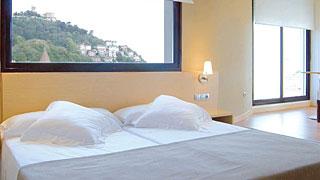
The Codina Hotel is located 300 metres from Ondarreta Beach, in San Sebastián.
It is a 3-star hotel designed to offer you a pleasant stay in the city. Remodelled in 2006, the building is modern and welcoming. The Sercotel Codina Hotel offers 65 rooms equipped with all the amenities, including free WiFi Internet. Because of its location and facilities, this hotel is one the best accommodation option for your visit to this famous city.
Hotel Flysch
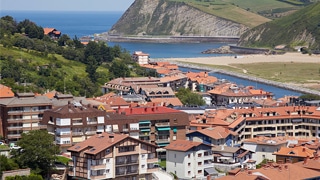
An unrepeatable experience. Unbeatable views, only metres from the authentic Zumaia Flysch.
The Hotel Flysch is a newly built construction designed to ensure that visitors enjoy a restful and comfortable experience. You’ll find us in Zumaia, directly above the famous Flysch (making our location a privileged spot) and only a moment’s walk from the San Telmo hermitage.
Hotel Silken Palacio Uribarren
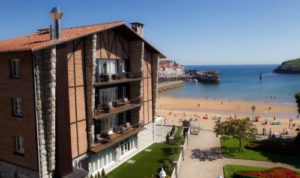
The Silken Palacio Uribarren is in an unbeatable location with superb views of the sea, the slopes of Mount Lumentza and Mount Otoio.
This hotel in Lekeitio overlooks Isuntza beach, close to Santa María de la Asunción Basilica and beside the harbour, one of the most popular areas for eating pintxos. It is within easy walking distance of the harbour wall which offers spectacular views of the sea. All rooms have a free, high-speed Wi-Fi connection, satellite TV with international channels, USB chargers, automatic doors with proximity sensors, a mini-bar and a safe. Also, you will find a salt water swimming pool, perfect for relaxing.
Hotel Atalaya
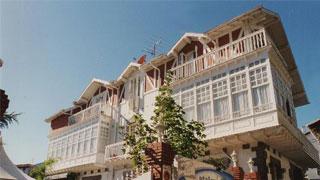
The Hotel Atalaya, built in 1911, is housed in a listed building of architectural interest.
This hotel stands just a few metres from the sea and the famous Mundaka surfing zone. Beautifully decorated in a mix of old and new and with spacious rooms and a peaceful terrace for breakfast, this is a delightful guesthouse in Mundaka and the ideal place to rest your head for the night.
Hotel Bahia
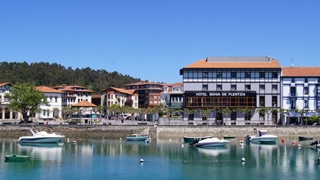
Hotel Boutique Bahía de Plentzia is brand new but it keeps the essence of the antique key building that was some years ago in Plentzia village.
Located in an amazing place, next to Plentzia river and surrounded of nature and beaches. Hotel Boutique Bahía de Plentzia is the right place to visit Basque Country and to get involved in our culture and gastronomy.
Hotel NH Hesperia Zubialde
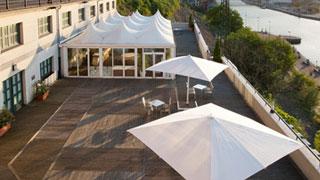
Guests appreciate the calm, comfortable facilities and high-quality services in a fully-renovated building that has held on to its traditional charm.
The four-star Hesperia Zubialde hotel in Bilbao is centrally located and very near major attractions such as the San Mames stadium and the world-renowned Guggenheim Museum.
On a Bike Spain Tours vacation, understanding and abiding by the rules of safe cycling is vital.
You’re probably familiar with some common safety guidelines. Below are those that we follow at Bike Spain, and we ask that you follow them while traveling with us:
Being on a bike tour shouldn’t mean constantly worrying about your bike breaking down. Nevertheless, bikes are machines, and issues can occur. Here’s what to look for if something doesn’t sound, feel, or work right.
ACCIDENTS: In case of an accident, keep calm, get off the road and go to a safe place (such as the hard shoulder) where you can evaluate the problem. If you suspect that you need medical care, call the Spanish emergency services on 112, explaining clearly where you are and what the problem is. Have your passport and your insurance documentation handy before calling. Please contact our office immediately after speaking with emergency services.
Remember that personal insurance it is not included on our self-guided tours. We offer an optional insurance policy. If you choose not to purchase this, please make sure that you keep own insurance documentation with you (including your passport).
The tour price does not include any roadside assistance with bicycle maintenance (e.g. flat tires) or any other taxi transfers during the tour. Any repairs that need to be caarried out on the bicycles that are not a result of negligence on Bike Spain Tours’ part will be paid for by the client.
HELMET: Cycling on the road in Spain without a helmet is illegal and unsafe; remember to wear your helmet at all times.
To check the weather before you leave on your trip, please take a look at current weather conditions at www.weatheronline.co.uk. For historical temperature and precipitation statistics visit www.weatherbase.com or take a look at the Spanish Meteorological website with detailed information per region (http://www.aemet.es/en/elclima/datosclimatologicos/valoresclimatologicos)
The history of Spain is a compendium of influences from the different cultures that have lived in the country. The first settlers on the Peninsula were the Celts and the Iberians. The Roman presence in Hispania lasted for seven centuries, during which time the basic borders of the Peninsula in relation to other European towns were set up. Many institutions were inherited from Rome such as the concept of family, Latin as a language, religion and law. At the start of the 5th century new settlers from the North arrived and settled on the Peninsula: the Visigoths in the interior and the Swabians on the West. The decomposition of the Visigoth state apparatus would lead to the successive infiltration of Arab and Berber troops from the other side of the Straits of Gibraltar at the beginning of the 8th century. In the middle of the 8th century the Muslims had completed occupation and Cordoba became the center of the flourishing Andalusian state. The Arab presence in Spain would last for almost seven centuries and leave an indelible mark on the Spanish cultural heritage.
Following a long period of peaceful coexistence, the small Christian strongholds in the North of the Peninsula took on a leading role in the Reconquest, which ended with the capture of Granada in 1492 under the reign of the Catholic King and Queen, traditionally considered the founders of peninsular unity and the imperial management of the Spanish revival. The 16th century represents the zenith of Spanish hegemony in the world, a process that would last until the middle of the 17th century. Following the death of Charles II, the last of the Austrians, who died without having had children, Phillip V inaugurated the dynasty of the Bourbons of Spain.
The crisis of the Old Order opened the doorway to the Napoleonic invasion. The War of Independence was a war against the French invasion, but also a revolutionary war due to the decisive involvement of the people and the clear formation of a national consciousness that would later shape the 1812 Constitution. The Courts of Cadiz thereby enacted one of the first Constitutions of the world which ratified that sovereignty would reside in the nation. The conflict between liberalists and absolutists, or in other words, between two different ways of perceiving the establishment of the state, would be one of the longest Spanish conflicts throughout the 19th century.
The ballot box is introduced into Spain and with it the first democratic experience of the 20th century: the second Republic, a brief attempt to introduce the reformations the country needed, frustrated by General Franco’s military rising and the outbreak of the Civil War in 1936. The military victory of General Franco gave way to a long dictatorial period that would last until 1975. Following his death, the Spanish peacefully made the transition from dictatorship to democracy in a process known as ‘the Spanish model’. Don Juan Carlos I, as King of the Spanish people, became the chief of a social and democratic state of law, which molded the Constitution of 1978.
More information…? Should you be interested in a specific theme, please check here, you will find many info about culture, environmental issues, nature, society, geography and politics.
In Spain you have exquisite and innovative dishes with the guarantee of internationally prestigious chefs. The highest quality products from the best producers, recipes combining popular tradition with artistic creation and offer you exciting, new flavors. Spain’s culinary revolution, headed by master chefs like Ferrán Adriá, Arzak and Berasategui turns the pleasure of good food into a luxury for the senses that is at its finest when savored in Spain.
Spanish cuisine is nowadays recommended in the finest restaurants, heralded by the most prestigious critics and demanded by millions of consumers over the world. It has gone through a real revolution, which, in the time of a few short years, has put Spain at the top of international cuisine. With traditional styles as the basis, a modern, innovative cuisine has developed, identified by the use of quality products and by the creativity of its chefs.
To read more about Spain’s cuisine
With regards to food, the Basque Country is probably the most important tourist destination in Spain. A coastal
and border region, whose very varied culinary delights are due to the mixture of sea and mountain cultures with
modern top-quality cooking. This trend emerged over the last decades with the appearance of the so-called Basque Nouvelle Cuisine. But most importantly, the good food is a reflection of the character of the Basque people, a people devoted to tradition and good food, the centre of any social occasion. The Basque Country, a culinary paradise.
Due to its geographical position in the Bay of Biscay, the Basques have been avid sailors for many centuries. Its constant fishing on the shore of Terranova has resulted in the consumption of cod on mass. The cod is a fish which in the past was consumed on the mainland to fight off the famine and which today has been converted into a delicacy, forming part of numerous recipes. The sauces which have emerged due to this fish – “pil pil” (garlic), Biscay sauce, green sauce, “ajoarriero” (eggs and garlic) – have become real institutions over the years and are proof of the region’s age-long capacity of producing sophisticated meals with the excellent raw materials at hand.
Info
About UsContact Info
Plaza de la Villa 1,
28005 Madrid
+34 915 590 653
info@bikespain.com
